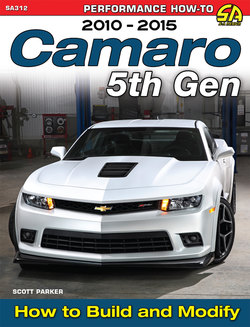Читать книгу Camaro 5th Gen 2010-2015 - Scott Parker F. - Страница 5
На сайте Литреса книга снята с продажи.
ОглавлениеPREFACE
Those were dark days in the early aughts when General Motors canceled the production of the Camaro. General Motors’ enthusiasts were forced to make due with a converted Australian sedan and the back-seat-less Corvette. Although both were formidable options, they simply could not replace the Camaro. It is a legendary nameplate with faithful followers who just wouldn’t convert. The power of the brand was just so strong that Chevrolet had to bring it back. Enthusiasm had only been building for the LS platform, as stock fourth-generation Camaros were becoming hard to come by. And today no one thinks twice about putting an LS engine in anything from a 1969 Camaro to a Porsche 911. Although some looked at the Camaro’s absence as a negativism, today you can look back on it as a caesura in its lyrical history. The pause added punctuation to what had become a literal powder keg.
January 9, 2006, was a momentous day for GM enthusiasts. At the time, I was still a little green as associate editor of GM High-Tech Performance (GMHTP) magazine when General Motors unveiled the Camaro at Cobo Hall in Detroit, Michigan. But the excitement within our staff and enthusiasts was palpable. It already had a formidable engine to power it, the 400-horse LS2 V-8, so it just needed the new Zeta chassis to call home. A year later General Motors served up the Pontiac G8 GT sedan as an hors d’oeuvre, which used the same chassis and the lower compression, rectangular-port L76.
By the time the 2010 Camaro coupe hit the streets three years later, I was at the helm of GMHTP. The production cars were available prior to the press cars, so I arranged to drag test a stick and an automatic with private owners who had placed early orders. By that time, the magazine had been moved to Tampa, Florida, where I located an automatic version and headed to Bradenton Motorsports Park. In the heat and humidity, it went 13.38 at 105 mph. A week or so later, I headed back to New Jersey to test Redline Motorsports’ stick car, which went 13.09 at 110 mph at the legendary Englishtown Raceway Park. The stick car later went 12.89 with more seat time and better conditions. Despite some regression from the fourth-gen, the fifth-gen was far superior to the Challenger R/T Classic that was tested on the same day.
At news of the testing, fourth-gen purists cried fowl. Instead of remembering the early days of the LS1, they tended to remember the times run in mineshaft conditions by professional drivers after nine years of familiarity with the platform. As time has gone on, the fifth-gen has proven to be a formidable platform even for drag racing. But it has taken some adjustments and changes in thought. As someone who has owned several fourth-gens, I originally preferred it as a drag racing platform. But the retro modern looks of the fifth-gen, combined with its safety, are particularly appealing if you prefer to drive your Camaro on the street (as many of us do).
Case in point: I wouldn’t think twice about strapping my daughter into the car seat in the rear of a fifth-gen. Fourth-gen? Not so much. And if you are building a dedicated race car, it is not hard to drop some serious weight out of the chassis. That’s why it is not surprising that as the fifth-gen has become more affordable in the secondary (used) car market, you are seeing more of them at the track.
It has been my privilege to cover the Camaro’s rebirth, as well as the gamut of modifications that tuners and builders have undertaken. I was at the first drive of the 2012 Camaro ZL1 at Virginia International Raceway, the 1LE at Gingerman, and countless National Muscle Car Association (NMCA) races, including the Fastest Fifth-Gen Shootout that I conceived and sponsored as editor of GMHTP. I hope that the knowledge accumulated from these events, racers, enthusiasts, and experts throughout the industry can help others who love the fifth-generation Camaro for years to come.
